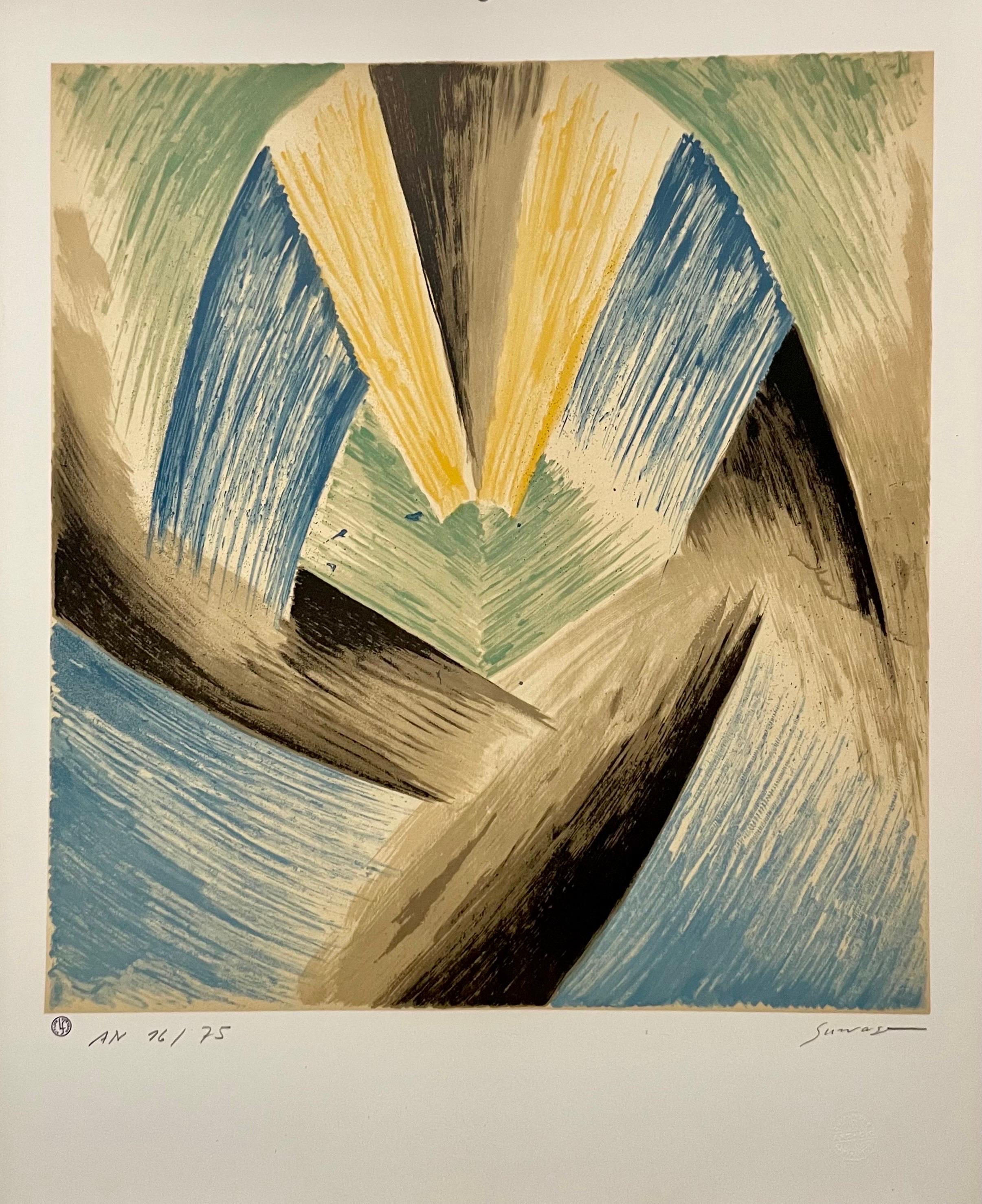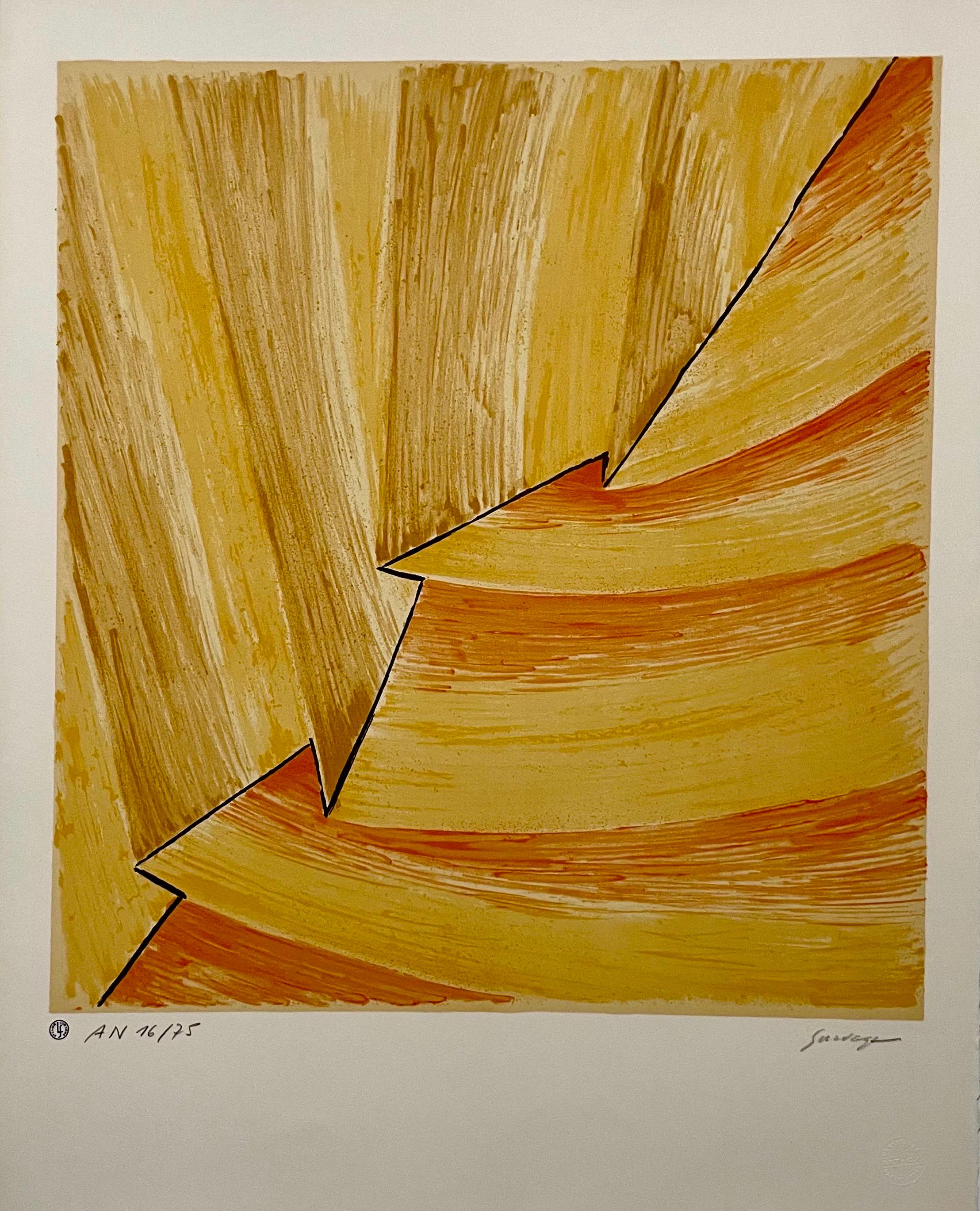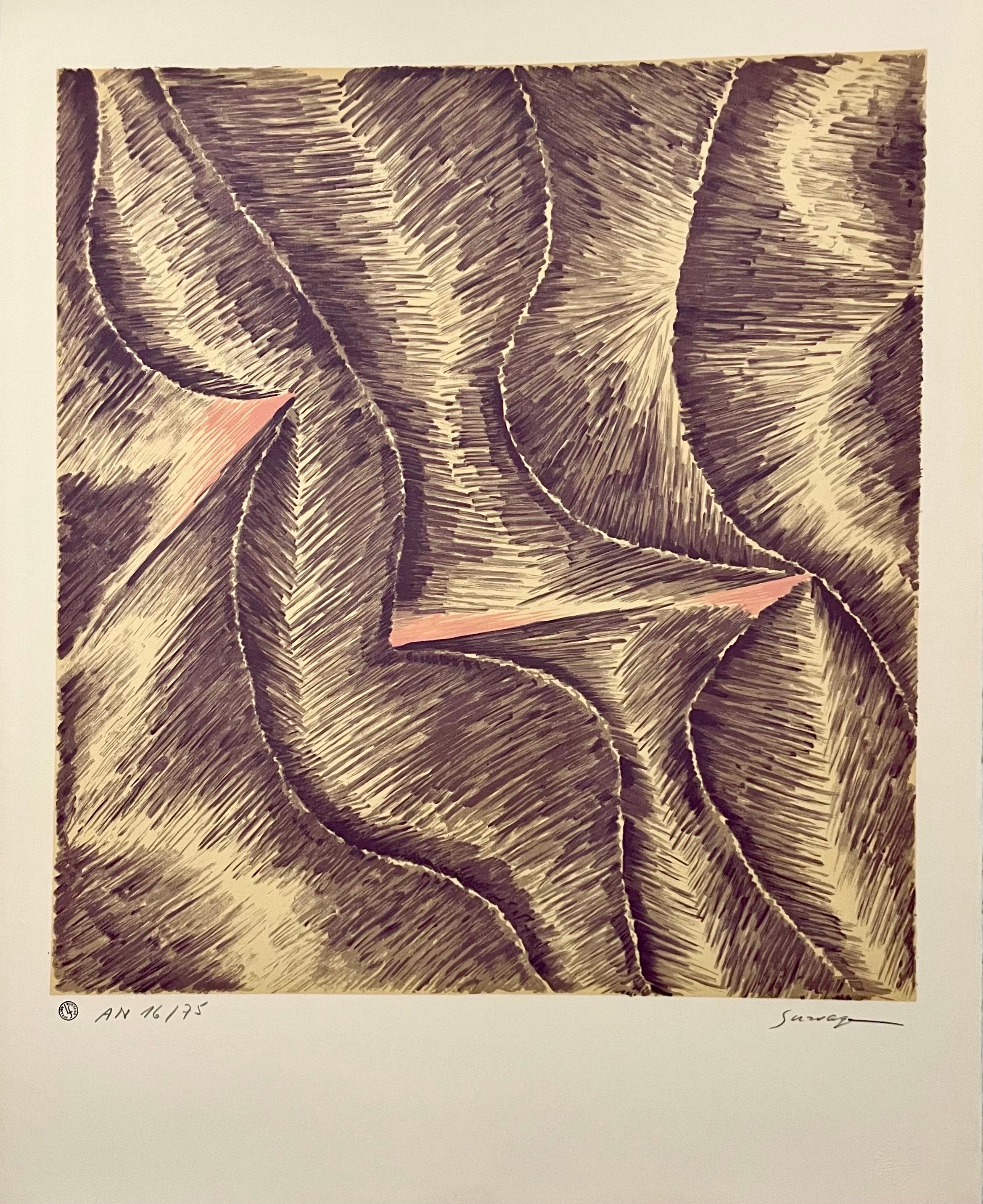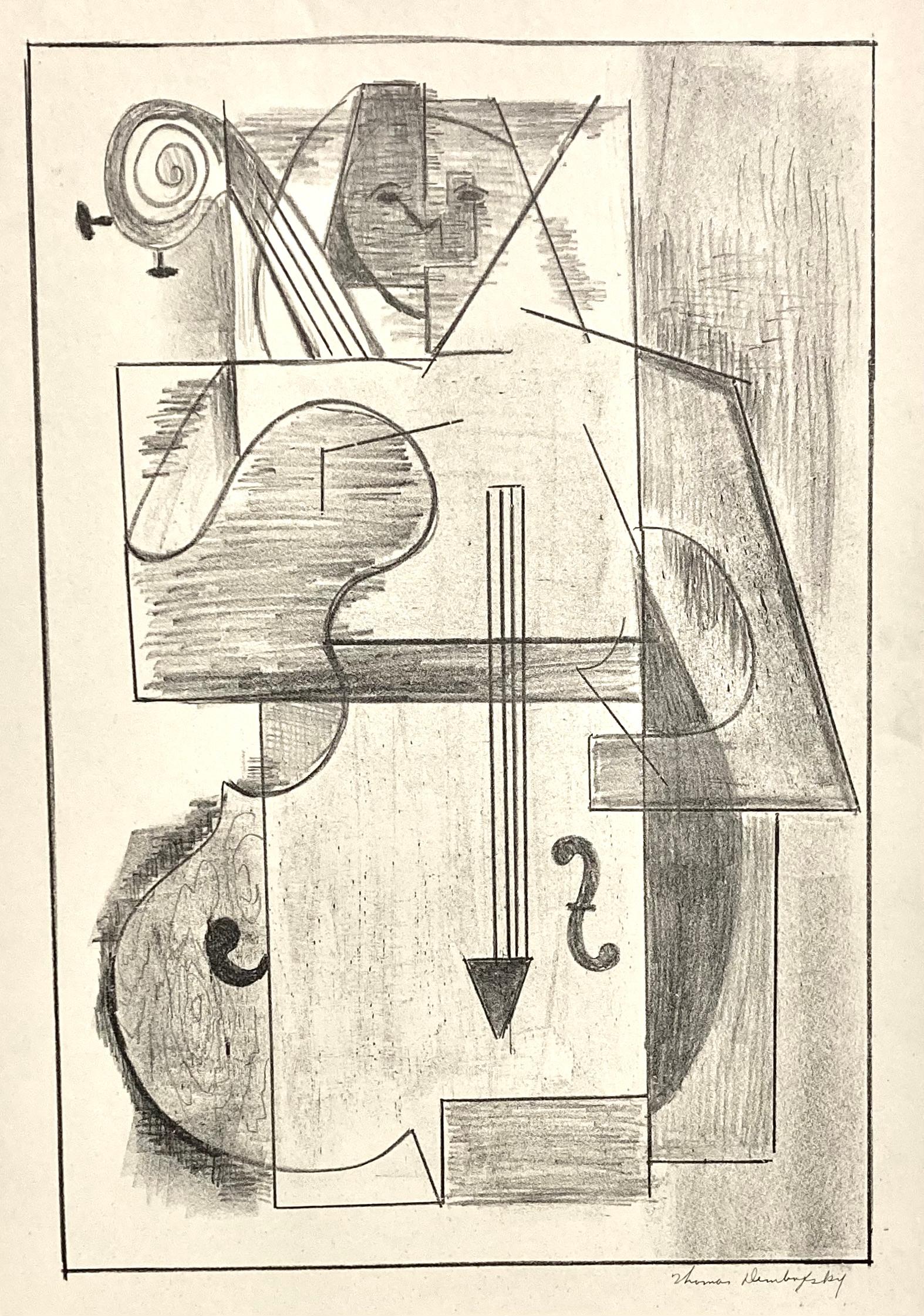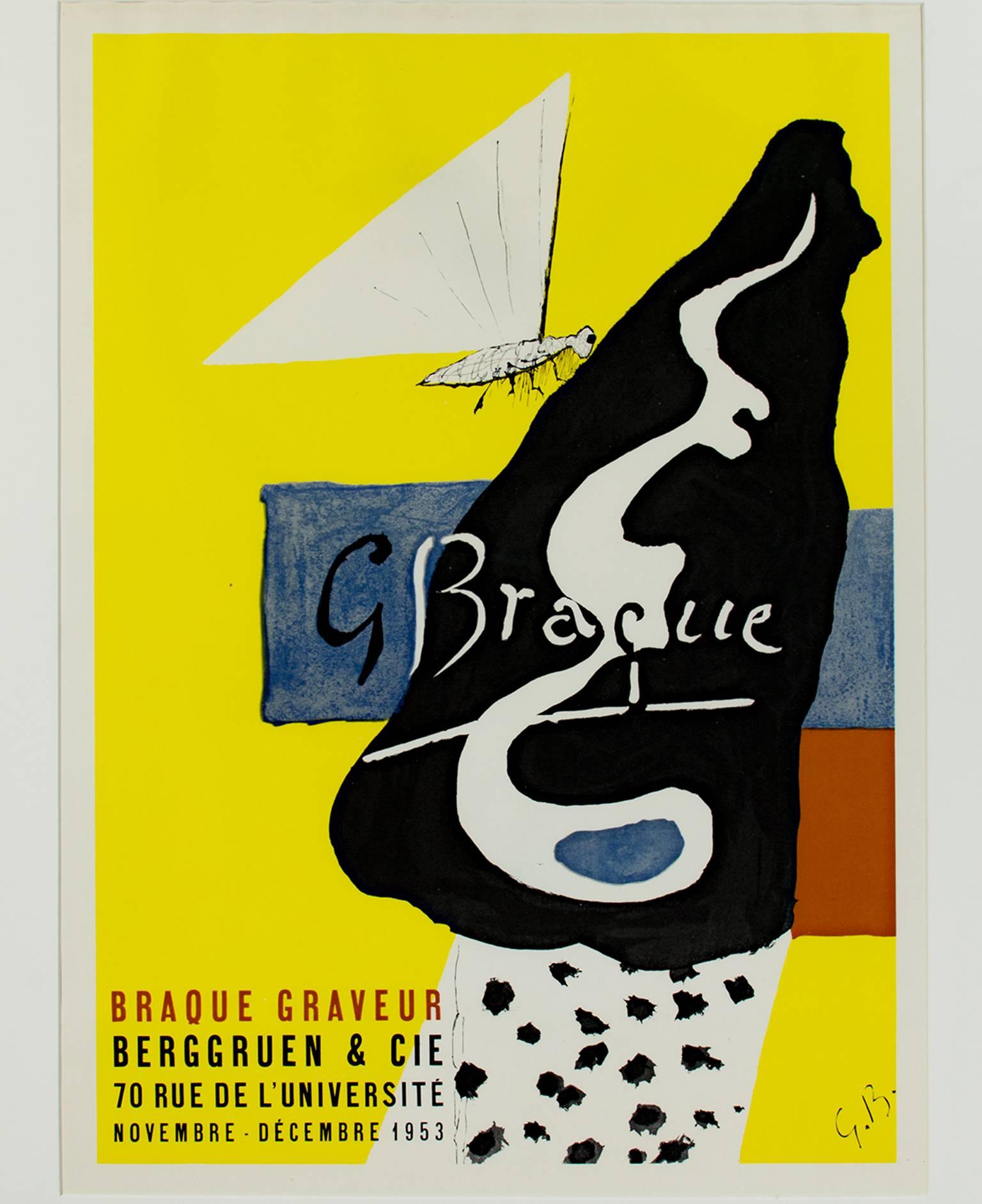Léopold SurvageRussian French Avant Garde Lithograph Rhythm in Colour Vibrant Abstract Print1967-1968
1967-1968
About the Item
- Creator:Léopold Survage (1879-1968)
- Creation Year:1967-1968
- Dimensions:Height: 25.5 in (64.77 cm)Width: 20.13 in (51.14 cm)
- Medium:
- Movement & Style:
- Period:
- Condition:good. this has never been framed.
- Gallery Location:Surfside, FL
- Reference Number:1stDibs: LU3829982762
Léopold Survage
At a young age, Léopold Survage was directed to enter the piano factory operated by his Finnish father. He learned to play piano and then completed a commercial diploma in 1897. After a severe illness at the age of 22, Survage rethought his career and entered the Moscow School of Painting, Sculpture and Architecture. Introduced to the modern movement through the collections of Sergei Shchukin and Ivan Morozov, he cast his lot with the Russian avant-garde and, by 1906, was loosely affiliated with the circle of the magazine Zolotoye runo. He met Alexander Archipenko, exhibiting with him in the company of David Burlyuk, Vladimir Burlyuk, Mikhail Larionov and Natalia Goncharova.
With Hélène Moniuschko, later his wife, he traveled to Western Europe, visiting Paris in July 1908. The couple eventually settled in Paris where Survage worked as a piano tuner and briefly attended the short-lived school run by Henri Matisse. He exhibited with the Jack of Diamonds group in Moscow in 1910 and first showed his work in France at the urging of Archipenko in the Salon d'Automne of 1911. In 1913, Survage produced abstract compositions using color and movement to evoke a type of musical sensation. Entitled Rythmes colorés, he planned to animate these illustrations using film to form "symphonies en couleur". He saw these abstract images as flowing together, but he exhibited the ink wash drawings separately at the Salon d'Automne in 1913 and Salon des Indépendants in 1914. Articles on these works were published by Guillaume Apollinaire (Paris-J., July 1914) and Survage himself (Soirées Paris, July–August 1914).
In June 1914, to develop his idea, Survage unsuccessfully applied for a patent to the Gaumont Film Company. Had he been able to raise the funds, he would have preceded Viking Eggeling and Hans Richter as the first to develop abstract films. Beginning in 1917, Survage shared a studio and a penchant for alcoholic excesses with Amedeo Modigliani in Paris. Survage later moved to Nice and, over the next eight years, produced highly structured oils and works on paper linked together by a series of leitmotifs, repeating groups of symbolic elements—man, sea, building, flower, window, curtain, bird as if they were protagonists in a series of moving images. The influence may have been Marc Chagall's, an artist well known for his insertions of floating couples, cows, roosters, and sundry Jewish iconography. By 1922, Survage had begun to move away from Cubism in favor of the neo-classical form. He was perhaps influenced by commissions for Serge Diaghilev's Ballets Russes, beginning with sets and costumes for Igor Stravinsky's opera buffa Mavra at the Paris Opéra in 1922. Although mainly a painter, he also produced stage, tapestry, and textile designs during this period (notably for the house of Chanel in 1933). Toward the end of the 1930s, as a result of his contact with André Masson, Survage became increasingly charmed by symbols and mysticism. The curvilinear forms that had previously dominated his compositions came, once again, under the control of the geometric structure. Survage was inducted into France's Légion d'Honneur in 1963. He died on 31 October 1968 in Paris.
- ShippingRetrieving quote...Ships From: Surfside, FL
- Return PolicyA return for this item may be initiated within 3 days of delivery.
- Russian French Avant Garde Lithograph Rhythm in Colour Vibrant Abstract PrintBy Léopold SurvageLocated in Surfside, FLLéopold Survage (French/Russian, 1879-1968), "Rythmes Colorés", 1967-1968 Lithograph on Vélin d'Arches paper, Printed by Mourlot, Paris Hand signed in pencil and numbered "AN 16/75"...Category
1960s Cubist Abstract Prints
MaterialsLithograph
- Russian French Avant Garde Lithograph Rhythm in Colour Vibrant Abstract PrintBy Léopold SurvageLocated in Surfside, FLLéopold Survage (French/Russian, 1879-1968), "Rythmes Colorés", 1967-1968 Lithograph on Vélin d'Arches paper, Printed by Mourlot, Paris Hand signed in pencil and numbered "AN 16/75"...Category
1960s Cubist Abstract Prints
MaterialsLithograph
- Russian French Avant Garde Lithograph Rhythm in Colour Vibrant Abstract PrintBy Léopold SurvageLocated in Surfside, FLLéopold Survage (French/Russian, 1879-1968), "Rythmes Colorés", 1967-1968 Lithograph on Vélin d'Arches paper, Printed by Mourlot, Paris Hand signed in pencil and numbered "AN 16/75"...Category
1960s Cubist Abstract Prints
MaterialsLithograph
- American Modernist Cubist Lithograph Screenprint "Reclining Woman" Max WeberBy Max WeberLocated in Surfside, FLReclining Cubist Nude Woman Max Weber (April 18, 1881 – October 4, 1961) was a Jewish-American painter and one of the first American Cubist painters who, in later life, turned to more figurative Jewish themes in his art. He is best known today for Chinese Restaurant (1915), in the collection of the Whitney Museum of American Art, "the finest canvas of his Cubist phase," in the words of art historian Avis Berman. Born in the Polish city of Białystok, then part of the Russian Empire, Weber emigrated to the United States and settled in Brooklyn with his Orthodox Jewish parents at the age of ten. He studied art at the Pratt Institute in Brooklyn under Arthur Wesley Dow. Dow was a fortunate early influence on Weber as he was an "enlightened and vital teacher" in a time of conservative art instruction, a man who was interested in new approaches to creating art. Dow had met Paul Gauguin in Pont-Aven, was a devoted student of Japanese art, and defended the advanced modernist painting and sculpture he saw at the Armory Show in New York in 1913. In 1905, after teaching in Virginia and Minnesota, Weber had saved enough money to travel to Europe, where he studied at the Académie Julian in Paris and acquainted himself with the work of such modernists as Henri Rousseau (who became a good friend), Henri Matisse, Pablo Picasso, and other members of the School of Paris. His friends among fellow Americans included some equally adventurous young painters, such as Abraham Walkowitz, H. Lyman Sayen, and Patrick Henry Bruce. Avant-garde France in the years immediately before World War I was fertile and welcoming territory for Weber, then in his early twenties. He arrived in Paris in time to see a major Cézanne exhibition, meet the poet Guillaume Apollinaire, frequent Gertrude Stein's salon, and enroll in classes in Matisse's private "Academie." Rousseau gave him some of his works; others, Weber purchased. He was responsible for Rousseau's first exhibition in the United States. In 1909 he returned to New York and helped to introduce Cubism to America. He is now considered one of the most significant early American Cubists, but the reception his work received in New York at the time was profoundly discouraging. Critical response to his paintings in a 1911 show at the 291 gallery, run by Alfred Stieglitz, was an occasion for "one of the most merciless critical whippings that any artist has received in America." The reviews were "of an almost hysterical violence." He was attacked for his "brutal, vulgar, and unnecessary art license." Even a critic who usually tried to be sympathetic to new art, James Gibbons Huneker, protested that the artist's clever technique had left viewers with no real picture and made use of the adage, "The operation was successful, but the patient died."[8] As art historian Sam Hunter wrote, "Weber's wistful, tentative Cubism provided the philistine press with their first solid target prior to the Armory Show." The Cellist...Category
Mid-20th Century Cubist Abstract Prints
MaterialsScreen
- Figural Abstract Mid Century Modern Lithograph Portraits, Judaica, Jewish PrintBy Rita GombinskiLocated in Surfside, FLThis is a proof print and is unsigned. it has Jewish Hebraic motifs, a menorah with a Jewish star, a mezusah or megilla scroll by this talented Jewish woman artist. Her whole life lo...Category
Mid-20th Century Cubist Figurative Prints
MaterialsCanvas, Oil
- Abstract Minimalist Color Silkscreen Print Richard Smith On The Bowery Pop ArtBy Richard SmithLocated in Surfside, FLRichard Smith On the Bowery, 1969 - 1971 silkscreen on Schoeller's Parole Paper, edition of 100 + 20 A.P. 25.5 x 25.5 inches, signed, numbered 21/100 Screenprint in color on wove paper Hand signed, published by Edition Domberger, Bonlanden, West Germany (with their blindstamp) Provenance: Collection of Tom Levine On the Bowery, 1971. The portfolio consists of nine screenprints in colors (one with mylar collage), on wove paper, by representative artists of the Pop Art period. Cy Twombly, Robert Ryman, Will Insley, Robert Indiana, Les Levine, John Willenbecher...Category
1960s Pop Art Abstract Prints
MaterialsLithograph, Screen
- 1956 Fernand Leger Mourlot Exhibition PosterBy Fernand LégerLocated in Wilton Manors, FL76 x 52 cm. Printed by Fernand Mourlot on rag paper watermarked "Mourlot." A condition. Not in Saphire. .Fernand Mourlot was born in Paris in 1895. He grew up in the family print shop but it wasn't until he took over in the early 1920s that he would change the fabric of printing forever. His influence fostered a resurgence of lithography, revealing it as a new avenue for expression and a new realm of possibilities for likes of Pablo Picasso, Henri Matisse, Marc Chagall, Joan Miró, Georges Braque, Fernand Léger, and Alberto Giacometti to enrich their own work as well as fine art in general. Fernand cultivated the lithograph as a painter's medium and the family studio on Rue Chabrol became a hub where he could invite artists to work directly on the stone, as if creating a poster. In 1937, the studio produced two posters (based on paintings by Matisse...Category
Mid-20th Century Cubist Abstract Prints
MaterialsPaper, Lithograph
- Thomas Dembovsky (sp?), (Cubist Musician)Located in New York, NYThis full-on view of a musician and his bass (also known as an upright bass or string bass), has an air of calm befitting the lowest-pitched bowed instrum...Category
1930s Cubist Interior Prints
MaterialsLithograph
- "Braque Graveur, " an Original Lithograph Poster signed Georges BraqueBy Georges BraqueLocated in Milwaukee, WI"Braque Graveur" is an original color lithograph poster signed with initials by the artist Georges Braque. It depicts a moth or butterfly landed on a black abstract form. There are b...Category
1950s Synthetic Cubist Abstract Prints
MaterialsLithograph
- Homme couche et femme accroupieBy Pablo PicassoLocated in Fairlawn, OHHomme couche et femme accroupie Lithograph on Arches paper, 1956 Signature stamp lower right )see photo) Annotated in pencil lower left: "epreuve d'artiste" (see p[hoto) Edition: 50, plus a few artist's proofs One of at least six artist's proofs apart from the edition of 50 Printed by Mourlot, Paris Inventory number verso: 50. Edition: 50, plus a few artist's proofs One of at least six artist's proofs apart from the edition of 50 Provenance: Pablo Picasso Inventory number verso: 50.014 (recorded in the Picasso Archives, Paris) Marina Picasso Collection...Category
1950s Cubist Abstract Prints
MaterialsLithograph
- Composition au verre a pied (Composition with stemmed glass)By Pablo PicassoLocated in Fairlawn, OHUnsigned Edition: a proof outside the edition of 50 printed on Japan Hodomura paper and the additional 50 impressions printed for the book Jaime Sabartes, "Dans l'atelier de Picasso...Category
1940s Cubist Abstract Prints
MaterialsInk, Lithograph
- Toro and HorseBy Ralston CrawfordLocated in Fairlawn, OHToro and Horse Lithograph, 1957 Signed and numbered in pencil by the artist. Titled in pencil lower left. Edition: 25 (24/25) Printer: Ravel, Paris Reference: Freeman L57.11 'Toro and Horse' was inspired by Spanish bullfighting...Category
1950s Cubist Prints and Multiples
MaterialsLithograph
